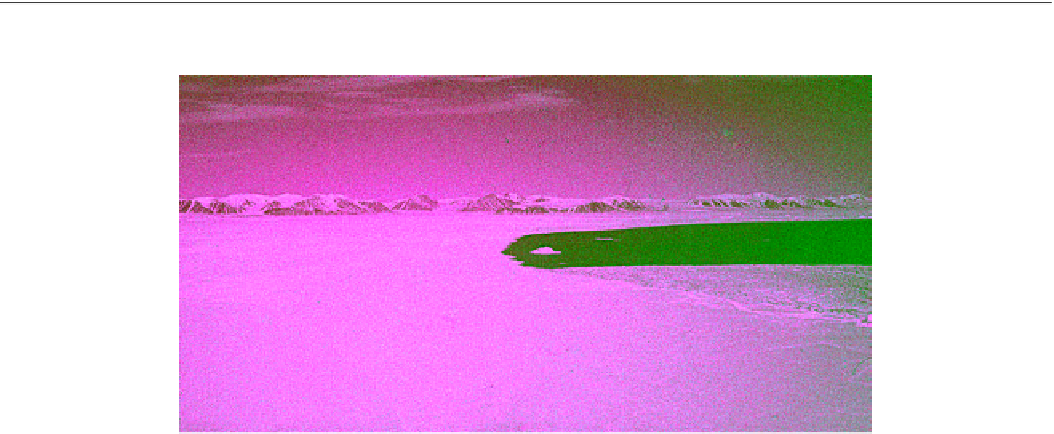Geology Reference
In-Depth Information
Table 2.7
Sea ice types based on surface form.
Ice Surface Type
Subtype
Definition
Level ice
Ice unaffected by deformation.
Rafted ice
Rafted
Deformed ice formed by one piece of ice overriding another.
Finger rafted
Floes thrust “fingers” alternately over and under the other,
common in nilas.
Ridged ice*
Ice piled haphazardly one piece over
another in the form of ridges or walls
and usually found in first‐year ice.
New ridge
Ridge with sharp peaks and slope of sides usually 40° or more.
Fragments are visible from the air at low altitude.
Weathered ridge
Ridge with peaks slightly rounded and slope of sides usually
30-40°. Individual fragments are not discernible.
Very weathered
ridge
Ridge with tops very rounded. Slope of sides usually 20-30°.
Aged ridge
Ridge that has undergone considerable weathering. These
ridges are best described as undulations.
Consolidated ridge
A ridge in which the base has frozen together.
Hummock ice
Ice piled haphazardly to form an uneven surface. When
weathered, it has the appearance of smooth hillocks.
Note: *A ridged ice zone is an area of many ridges with similar characteristics (rubble field).
Figure 2.65
Aerial photograph of several icebergs and the southern section of the North Water Polynya in June 1984. Mountains
and glaciers of Ellesmere Island appear in the background (photo taken by N. K. Sinha).
They impart a significant control over the energy balance
of ice‐covered ocean surface. They are also biologically
important because they represent focal points for the
intense production of herbivores that trigger the food
chain; starting from planktonic and epontic algae up to
Arctic cod, seals, polar bear, and eventually humans.
Polynyas vary in area from a few thousands of square
kilometers (typical of coastal polynyas) to about
80,000 km
2
of the largest polynya in the Arctic; known as
the North Water (NOW) polynya.
Martin et al
. [1992]
show maps of polynya locations and sizes in the Arctic
and Antarctic regions. A review of polynya types, pro-
cesses, and ice formation mechanisms is covered in
Smith
et al
. [1990] and
Martin et al
. [1992]. A description of sea
ice types and processes in NOW is presented in
Mundy and
Barber
[2001]. A photograph of the southern section of
NOW, taken in June 1984, is presented in Figure 2.65. In
the background, the mountains and glaciers of Ellesmere
Island appear. Also visible is an iceberg in the open water.
The polynya always contains thin ice types, but this photo-
graph was taken in June after the ice has melted.
Based on the common mechanism of ice formation
and removal, two types of polynya are commonly known:
sensible heat and latent heat. Sensible heat polynya is
thermodynamically driven by warm upwelling water that
reaches the sea surface and prevents ice formation. This
type of polynya usually occurs away from the coast and
therefore is sometimes called open‐ocean polynya. Latent
heat polynyas, on the other hand, are mechanically driven
by wind or ocean current actions. They usually exist near
coastlines when offshore wind breaks the ice (usually
landfast ice) and drifts it away. Therefore, they are also
called coastal polynya. In both types, ice is removed
by melting or advection as soon as it is formed in the






